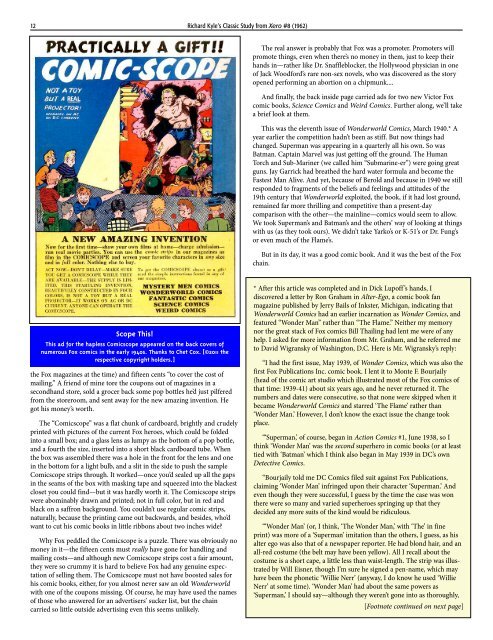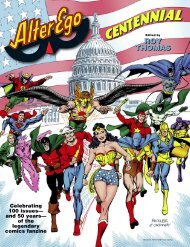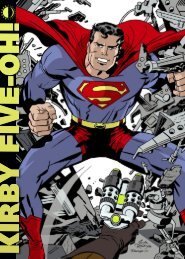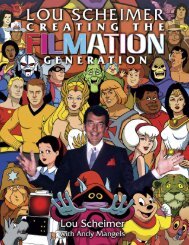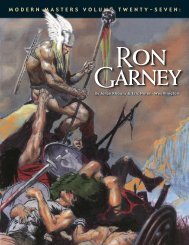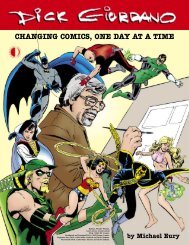The Education Of Victor Fox - TwoMorrows
The Education Of Victor Fox - TwoMorrows
The Education Of Victor Fox - TwoMorrows
You also want an ePaper? Increase the reach of your titles
YUMPU automatically turns print PDFs into web optimized ePapers that Google loves.
12 Richard Kyle’s Classic Study from Xero #8 (1962)<br />
<strong>The</strong> real answer is probably that <strong>Fox</strong> was a promoter. Promoters will<br />
promote things, even when there’s no money in them, just to keep their<br />
hands in—rather like Dr. Snaffleblocker, the Hollywood physician in one<br />
of Jack Woodford’s rare non-sex novels, who was discovered as the story<br />
opened performing an abortion on a chipmunk....<br />
And finally, the back inside page carried ads for two new <strong>Victor</strong> <strong>Fox</strong><br />
comic books, Science Comics and Weird Comics. Further along, we’ll take<br />
a brief look at them.<br />
This was the eleventh issue of Wonderworld Comics, March 1940.* A<br />
year earlier the competition hadn’t been as stiff. But now things had<br />
changed. Superman was appearing in a quarterly all his own. So was<br />
Batman. Captain Marvel was just getting off the ground. <strong>The</strong> Human<br />
Torch and Sub-Mariner (we called him “Submarine-er”) were going great<br />
guns. Jay Garrick had breathed the hard water formula and become the<br />
Fastest Man Alive. And yet, because of Berold and because in 1940 we still<br />
responded to fragments of the beliefs and feelings and attitudes of the<br />
19th century that Wonderworld exploited, the book, if it had lost ground,<br />
remained far more thrilling and competitive than a present-day<br />
comparison with the other—the mainline—comics would seem to allow.<br />
We took Superman’s and Batman’s and the others’ way of looking at things<br />
with us (as they took ours). We didn’t take Yarko’s or K-51’s or Dr. Fung’s<br />
or even much of the Flame’s.<br />
But in its day, it was a good comic book. And it was the best of the <strong>Fox</strong><br />
chain.<br />
Scope This!<br />
This ad for the hapless Comicscope appeared on the back covers of<br />
numerous <strong>Fox</strong> comics in the early 1940s. Thanks to Chet Cox. [©2011 the<br />
respective copyright holders.]<br />
the <strong>Fox</strong> magazines at the time) and fifteen cents “to cover the cost of<br />
mailing.” A friend of mine tore the coupons out of magazines in a<br />
secondhand store, sold a grocer back some pop bottles he’d just pilfered<br />
from the storeroom, and sent away for the new amazing invention. He<br />
got his money’s worth.<br />
<strong>The</strong> “Comicscope” was a flat chunk of cardboard, brightly and crudely<br />
printed with pictures of the current <strong>Fox</strong> heroes, which could be folded<br />
into a small box; and a glass lens as lumpy as the bottom of a pop bottle,<br />
and a fourth the size, inserted into a short black cardboard tube. When<br />
the box was assembled there was a hole in the front for the lens and one<br />
in the bottom for a light bulb, and a slit in the side to push the sample<br />
Comicscope strips through. It worked—once you’d sealed up all the gaps<br />
in the seams of the box with masking tape and squeezed into the blackest<br />
closet you could find—but it was hardly worth it. <strong>The</strong> Comicscope strips<br />
were abominably drawn and printed; not in full color, but in red and<br />
black on a saffron background. You couldn’t use regular comic strips,<br />
naturally, because the printing came out backwards, and besides, who’d<br />
want to cut his comic books in little ribbons about two inches wide?<br />
Why <strong>Fox</strong> peddled the Comicscope is a puzzle. <strong>The</strong>re was obviously no<br />
money in it—the fifteen cents must really have gone for handling and<br />
mailing costs—and although new Comicscope strips cost a fair amount,<br />
they were so crummy it is hard to believe <strong>Fox</strong> had any genuine expectation<br />
of selling them. <strong>The</strong> Comicscope must not have boosted sales for<br />
his comic books, either, for you almost never saw an old Wonderworld<br />
with one of the coupons missing. <strong>Of</strong> course, he may have used the names<br />
of those who answered for an advertisers’ sucker list, but the chain<br />
carried so little outside advertising even this seems unlikely.<br />
* After this article was completed and in Dick Lupoff ’s hands, I<br />
discovered a letter by Ron Graham in Alter-Ego, a comic book fan<br />
magazine published by Jerry Bails of Inkster, Michigan, indicating that<br />
Wonderworld Comics had an earlier incarnation as Wonder Comics, and<br />
featured “Wonder Man” rather than “<strong>The</strong> Flame.” Neither my memory<br />
nor the great stack of <strong>Fox</strong> comics Bill Thailing had lent me were of any<br />
help. I asked for more information from Mr. Graham, and he referred me<br />
to David Wigransky of Washington, D.C. Here is Mr. Wigransky’s reply:<br />
“I had the first issue, May 1939, of Wonder Comics, which was also the<br />
first <strong>Fox</strong> Publications Inc. comic book. I lent it to Monte F. Bourjaily<br />
(head of the comic art studio which illustrated most of the <strong>Fox</strong> comics of<br />
that time: 1939-41) about six years ago, and he never returned it. <strong>The</strong><br />
numbers and dates were consecutive, so that none were skipped when it<br />
became Wonderworld Comics and starred ‘<strong>The</strong> Flame’ rather than<br />
‘Wonder Man.’ However, I don’t know the exact issue the change took<br />
place.<br />
“‘Superman,’ of course, began in Action Comics #1, June 1938, so I<br />
think ‘Wonder Man’ was the second superhero in comic books (or at least<br />
tied with ‘Batman’ which I think also began in May 1939 in DC’s own<br />
Detective Comics.<br />
“Bourjaily told me DC Comics filed suit against <strong>Fox</strong> Publications,<br />
claiming ‘Wonder Man’ infringed upon their character ‘Superman.’ And<br />
even though they were successful, I guess by the time the case was won<br />
there were so many and varied superheroes springing up that they<br />
decided any more suits of the kind would be ridiculous.<br />
“‘Wonder Man’ (or, I think, ‘<strong>The</strong> Wonder Man,’ with ‘<strong>The</strong>’ in fine<br />
print) was more of a ‘Superman’ imitation than the others, I guess, as his<br />
alter ego was also that of a newspaper reporter. He had blond hair, and an<br />
all-red costume (the belt may have been yellow). All I recall about the<br />
costume is a short cape, a little less than waist-length. <strong>The</strong> strip was illustrated<br />
by Will Eisner, though I’m sure he signed a pen-name, which may<br />
have been the phonetic ‘Willie Nerr’ (anyway, I do know he used ‘Willie<br />
Nerr’ at some time). ‘Wonder Man’ had about the same powers as<br />
‘Superman,’ I should say—although they weren’t gone into as thoroughly,<br />
[Footnote continued on next page]


